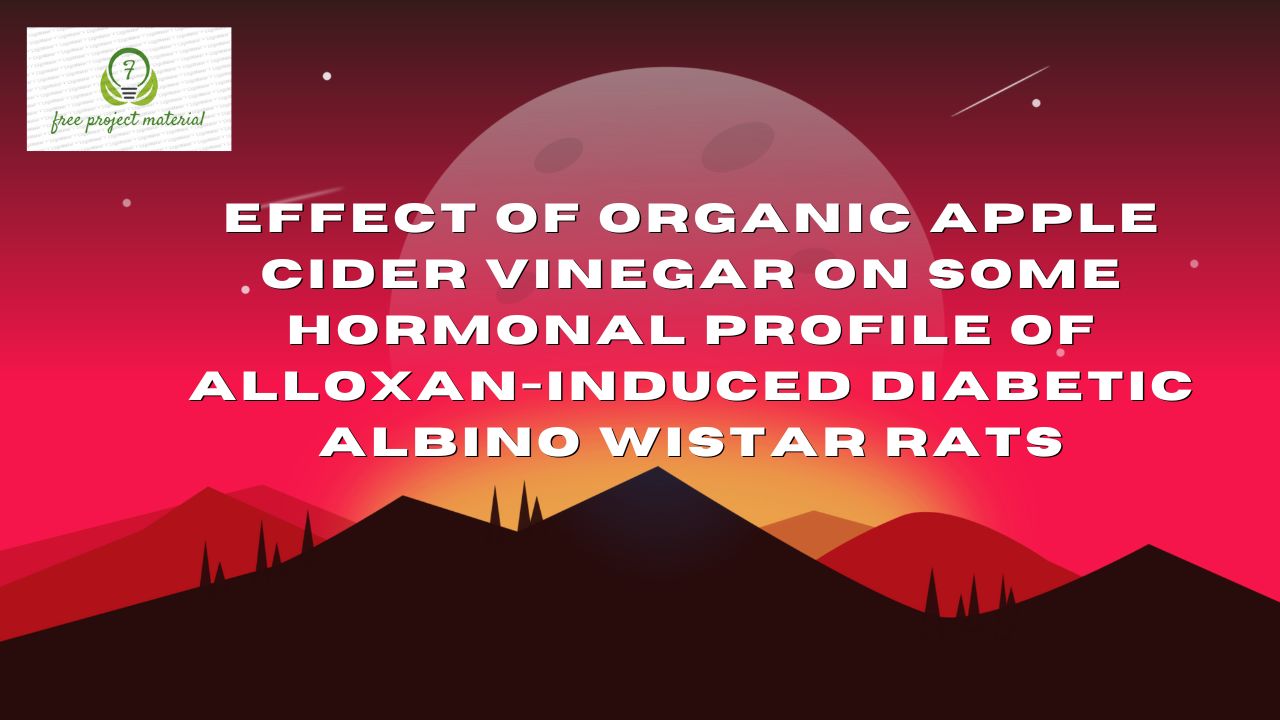ABSTRACTS
This study on the effect of apple cider vinegar on the hormonal profile of male albino Wister rats was carried using standard methods. Twenty-five (25) rats were randomly assigned five groups of five rats each. Group 1 was served as the control and was given free access to normal rat chow and water only; Group 2 was administered with alloxan, Groups 3, 4 and 5 were induced with alloxan. Thereafter, it was given 0.5ml, 1ml and 2ml/kg body weight of organic apple cider vinegar for 21days. The animals were also given free access to feed and water. The result of the study revealed that administration of alloxan result in significant decrease (P<0.05) of Testosterone in the alloxan-only treated group (group), while FSH and LH showed no significant changes when compared to the control. However, the treatment with apple cider vinegar significantly results in the increase of Testosterone, FSH and LH when compared to the control. This suggests fertility improvement activity of apple cider vinegar as well as anti-diabetic effects. Thus, it is recommended that apple cider vinegar could be used for treatment of infertility in men and management of diabetes.
Key words: Organic apple cider vinegar, alloxan, albino wistar rats, testosterone, follicle-stimulating hormone (FSH), Luteinizing Hormone (LH).
TABLE OF CONTENTS
Title Page – – – – – – – – – i
Certification – – – – – – – – – ii
Dedication – – – – – – – – – iii
Acknowledgement – – – – – – – – iv
Abstract – – – – – – – – – v
Table of Contents – – – – – – – – vi
List of Tables – – – – – – – – ix
List of Plates – – – – – – – – x
List of Figure – – – – – – – – xi
CHAPTER ONE: INTRODUCTION
1.1 Background of the study – – – – – – 1
1.2. Aims and Objectives – – – – – – 5
1.2.1 Aim of the study – – – – – – – 5
1.2.2 Objectives of the study – – – – – – 5
1.3 Significance of Study – – – – – – 6
1.4 Scope and Limitations – – – – – – 6
1.4.1 Scope of the study – – – – – – – 6
1.4.2 Limitation of the study – – – – – – 7
1.5 Definition of Terms – – – – – – 7
1.6 Abbreviations – – – – – – – 10
CHAPTER TWO: LITERATURE REVIEW
2.1 Description of Apple Cider Vinegar – – – – 12
2.2 Apple Cider Vinegar – – – – – – 15
2.3 Types of Apple Cider Vinegar – – – – – 18
2.4 Production of Apple Cider Vinegar – – – – 119
2.5 Pharmacological Importance of Apple Cider Vinegar – 20
2.5.1 Anti-Cancer Activity – – – – – – 20
2.5.2 Anti-Diabetic Activity – – – – – – 21
2.5.3 Anti-Inflammatory Activity – – – – – 23
2.5.4 Hepato Protective Activity – – – – – 24
2.5.5 Apple Cider Vinegar Role in Cognitive Impairments,
Immunomodulator effects – – – – – 24
2.6 Mechanism of Action of Alloxan – – – – 26
2.6.1 Chemistry and Molecular Formula of Alloxan – – 27
2.6.2 Structure of Alloxan – – – – – – 28
2.6.3 Beta Cell Selectivity of Alloxan – – – – – 28
2.6.4 Glucokinase Inhibition – – – – – – 29
2.6.5 Beta Cell Toxicity and Diabetogenicity of Alloxan – – 30
2.7 Hormonal Profile – – – – – – – 31
2.7.1 Follicle Stimulating Hormones – – – – – 31
2.7.2 Leutienizing Hormones – – – – – – 32
2.7.3 Testosterone – – – – – – – – 33
2.7.4 Estrogen and Progesterone – – – – – 34
2.8 Roles of Hormones in Spermiogenesis,
Spermiation and Sperm Maturation – – – 35
2.9 Diabetes Mellitus – – – – – – – 36
2.9.1 Signs and Symptoms of Diabetes Mellitus – – – 37
2.9.2 Diagnosis of Diabetes Mellitus – – – – 39
2.9.3 Mechanism of Action of Diabetes – – – – 41
CHAPTER THREE: MATERIALS AND METHODS
3.1 Materials – – – – – – – – 43
3.2 Methods – – – – – – – – 44
3.2.1 Sample Collection and Preparation – – – – 44
3.2.2 Preparation of Sample – – – – – – 45
3.2.3 Experimental Design and Grouping of Animals – – 45
3.2.4 Collection of Blood Samples – – – – – 47
3.3 Determination of Hormonal Profile Parameters – – 48
3.3.1 Determination of Testosterone – – – – – 48
3.3.2 Determination of Follicle-Stimulating Hormone – – 49
3.3.3 Determination of Luteinizing Hormone – – – 49
3.4 Statistical Analysis – – – – – – – 50
CHAPTER FOUR: RESULTS AND DISCUSSION
4.1 Morphology and Physiology of Rats – – – 51
4.2 Results – – – – – – – – 52
4.3 Discussion – – – – – – – – 54
CHAPTER FIVE: CONCLUSION AND RECOMMENDATIONS
5.1 Conclusion – – – – – – – – 59
5.2 Recommendations – – – – – – – 59
References
CHAPTER ONE: INTRODUCTION
1.1 Background of the study
Apple Cider Vinegar is useful in preventing metabolic disorders. Apple Cider Vinegar otherwise known as cider or vinegar is a type of vinegar made from cider or apple mustard and it has a pale to medium amber colour. The main component of vinegar is acetic acid. Unpasteurized apple cider vinegar contains mother of vinegar, which has a cobweb-like appearance and can make the vinegar look slightly congeated. Apple Cider Vinegar is used in salad dressings, marizades, vinaigrettes, food preservatives and chutneys. It is made by crushing apples and squeezing out the liquid. Bacteria and yeast are added to the liquid to start the alcoholic fermentation process and the sugar turned into alcohol is converted into vinegar by acetic forming bacteria (Acetobacter). Acetic acid and malic acid give vinegar is sour taste (Bouderbala et al., 2016). Although styles of cider are extremely diverse and not easy to categorize, depending on the type of apple juices used and the degrees of sweetness from extra dry to sweet and alcohol content, cider made from apple juice. The modern pharmaceutical industry based on synthetic chemistry severed the historical ties between plants, foods and medicines (Halima et al., 2016).
A hormone is any member of a class of signaling molecules produced by glands in multicellular organisms that are transported by the circulatory system to target distant organs to regulate physiology and behavior. Hormones have diverse chemical structures, mainly of 3 classes: Eicosanoids, Steroids and amino acid/protein derivatives (Amines, peptides and proteins). The glands that secrete hormones comprise the endocrine signaling system. The term hormone is sometimes extended to include chemicals produced by cells that affect the same cell (autocrine or intracrine signaling) or nearby cells (paracrine signaling). Hormones are used to communicate between organs and tissues for physiological regulation and behavioral activities such as digestion, metabolism, respiration, tissue function, sensory perception, sleep, excretion, lactation, stress, growth and development, movement reproduction and mood (Santoro and Neal-Perry, 2010). Testosterone is the primary male sex hormone and an anabolic steroid. In male humans, testosterone plays a key role in the development of male reproductive tissue such as the testis and prostate as well as promoting secondary sexual characteristics such as increased muscle and bone mass and the growth of body hair. In addition, testosterone is involved in health and well-being and the prevention of osteoporosis. Insufficient levels of testosterone in men may lead to abnormalities including frailty and bone loss. Since testosterone level gradually decrease as men age, synthetic testosterone is sometimes prescribed to older men to counteract this deficiency (Adler et al., 2012). While estrogens are present in both men and women, they are usually present at significantly higher levels in women of reproductive age. They promote the development of female secondary sexual characteristics such as breasts and are also involved in the thickening of the endometrium and other aspects of regulating the menstrual cycle. In males, estrogen regulates certain functions of the reproductive system important to the maturation of sperm and may be necessary for a healthy libido (Hill et al., 2004).
Alloxan and Streptozotocin are the most prominent diabetogenic chemicals in diabetes research. Both are cytotoxic glucose analogues. Although their cytotoxicing is achieved via different pathways, their mechanisms of beta cell selective action are identical. In some years Wohler and Liebig synthesized a pyrimidine derivative which they later called alloxan. Years after, alloxan became of interest in diabetes research when Dunn and McLetchie reported that it could induce diabetes in animals as a result of the specific necrosis of the pancreatic beta cells (Peschke et al., 2000). The resulting inswinopenia causes a state of experimental diabetes mellitus called “alloxan diabetes”. The reduction product of alloxan, dialuric acid had been shown to be diabetogenic in animals and to causes ultrastructural changes identical to those observed in response to alloxan.
Diabetes Mellitus often known simply as diabetes is a group of common endocrine diseases characterized by sustained high blood sugar level. Diabetes is due to either the pancreas not producing enough insulin or the cells of the body becoming unresponsive to the hormones effects (Shoback and Gardner, 2011). Classic symptoms include thirst, polyuria, weight loss and blurred vision. If left untreated, the disease can lead to various health complication including disorders of the cardiovascular system, eye, kidney and nerves (Kitabchi et al., 2009) Untreated of poorly treated diabetes accounts for approximately 1.5 million deaths every year.
1.2 Aims and Objective of the Study
1.2.1 Aim of the Study
The aim of this research project was to determine the effect of organic Apple Cider Vinegar on some hormonal profile of Alloxan induced diabetic Albino Wister Rats
1.2.2 Objectives of the study
The objectives of the research project were to determine:
- To observe the physical and Morphological changes in the alloxan induced Wister Rats and those treated with organic Apple Cider Vinegar.
- The effect of co-administration of organic Apple Cider Vinegar on the Follicle-stimulating hormone (FSH) of Alloxan-induced diabetic rats.
- The effect of co-administration of organic Apple Cider Vinegar on the Luteinizing hormone (LH) of alloxan-induced diabetic rats.
- The effect of co-administration of organic Apple Cider Vinegar on the testosterone of alloxan-induced diabetic rats.
1.3 Significance of the Study
The significant of this study is that:
- The result obtain from this research work will be useful to medical doctors, pharmacist etc. as it will help in ascertaining the efficacy of organic Apple Cider Vinegar in improving hormonal profile.
- This study will serve as a source of information to the public in order to guide their usage of the organic Apple Cider Vinegar.
- This study will also serve as a reference materials to researchers and students in this field.
1.4 Scope and Limitations
1.4.1 Scope of the Study
This research work is limited to the investigation of the effect of co-administration of organic Apple Cider Vinegar on some hormonal profile (Follicle-stimulating hormone, Luteinizing hormone and testosterone) of alloxan-induced diabetes rats.
1.4.2 Limitation of the Study
This research work is limited by time and financial constraints which prevented the expansion of this work beyond this stage.
1.5 Definition of Terms
Apple Cider Vinegar: is the fermented juice from crushed apples. It contains acetic acid and nutrients such as B vitamins and vitamin C. Apple Cider Vinegar is popularly used in salad dressings and cooking. But it’s also been used traditionally as medicine. It might help lower blood sugar levels after a meal by changing how foods are absorbed from the gut. Apple Cider Vinegar is used for obesity, diabetes, athletic performance, kidney stones and many other purposes but here is no good scientific evidence to support any of these uses.
Alloxan: Alloxan is a toxic chemical. It has been used to induce diabetes in experimental animals by destroying the insulin-secreting cells of Langerhans islet in pancreas.
Alloxan also has the capacity to induce diabetes through its action on the pancreas to reduce glucose mediated insulin secretion and induce selective necrosis of β-cells. It is possible to vary the severity of diabetes by using different doses of alloxan which therefore makes it useful to study the effects of a milder diabetic condition.
Hormones: Hormones are chemical messengers made by glands in the body which are carried in the blood to act on other organs in the body. Hormones are needed in the body for growth, reproduction and well-being.
Hormonal Profile: is a blood test that is one of the most common ways to test hormone levels. This test can detect testosterone, estrogen, cortisol, thyroid levels, follicle-stimulating hormones (FSH), Luteinizing Hormones (LH).
Testosterone: is the most important androgen (male sex hormone). It is needed to have normal reproductive and sexual function.
Testosterone is important for the physical changes that happen during puberty such as the development of the penis, testicles, facial and body hair and muscle growth. It acts on cells in the testicles to make sperm. It also important for overall good health, it helps the growth of bones and affects the mood and sex drive. Some testosterone is changed into oestrogen, the female sex hormone and this important for the bone health.
Follicle-stimulating Hormone (FSH): is a hormone the pituitary gland makes and releases that plays a role in sexual development and reproduction. It affects the function of ovaries and testicles. Despite its name, follicle-stimulating hormone doesn’t directly affect the hair follicles or hair growth. A special group of hormones called androgens affects hair growth, FSH got its name due to its effect on ovarian follicles which are small sacs filled with fluid that contain egg cells in ovaries.
Luteinizing Hormones (LH): stimulates processes in the body that are important for sexual health development and reproduction. A tiny structure in the brain called the pituitary gland secretes LH. In turn, LH causes changes in the sex organs (Ovaries or Testes) that allow the productive system to function correctly. LH is a chemical in the body that triggers important processes in the productive system. LH spurs ovulation and helps with the hormone production needed to support pregnancy. The provider may order a test to check the LH level, it an individual have fertility issues or irregular menstruation.
Diabetes: is a chronic disease that occurs either when the pancreas does not produce enough insulin or when the body cannot effectively use the insulin it produces. Insulin is a hormone that regulates blood glucose. Hyperglycaemia, also called raised blood glucose or raised blood sugar is a common effect of uncontrolled diabetes and over time leads to serious damage to many of the body’s systems especially the nerves and blood vessels.
Albino Wistar Rat: the Wistar at is an outbred stock used in all fields of medical and biological research. Its longevity and high rate of spontaneous tumours make it an ideal choice for agency studies. It is an albino strain, easy to handle, it is however slower learner than long Evans rat.
1.6 Abbreviations
AAB – Acidic Corrosive Microscopic Organisms
TDA – Tetra-decanoyl Phorbol -13-acetic Acid
ACV – Apple Cider Vinegar
HDL – High Density Lipoproteins
LDL – Low Density Lipoproteins
VLDL – Very low-density Lipoproteins
ATP – Adenosine Triphosphate
ROS – Reactive Oxygen Species
GSH – Tripeptide Glutathione
FSH – Follicle Stimulating Hormone
GnRH – Gonadotropin-releasing Hormone
CAMP – Cyclic Adenosine Monophosphate
LH – Leutienizing Hormone
DNA – Deoxyribonucleic Acid
RNA – Ribonucleic Acid
OGTT – Oral Glucose Tolerance Test
ADA – American Diabetes Association


